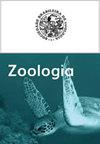模拟从孵化场到蚊虫幼虫生物防治目标区的运输过程中,长中环足桡足动物的存活
IF 1.8
4区 生物学
Q4 ZOOLOGY
引用次数: 1
摘要
桡足类动物已在许多国家成功地用于生物控制传播疾病的蚊子幼虫。在巴西,这条研究路线的重点是利用桡足类长尾猿(thi本文章由计算机程序翻译,如有差异,请以英文原文为准。
Survival of the copepod Mesocyclops longisetus during simulations of transport from hatchery to target areas for biological control of mosquito larvae
Copepods have been successfully used in many countries for the biological control of larvae of mosquitoes that vector diseases. In Brazil, this line of research has been focused on the use of the copepod Mesocyclops longisetus (Thiébaud, 1914) for the biological control of the mosquito Aedes aegypti (Linnaeus, 1792). The transportation of the copepods from the place where they are reared to where they will be used often involves long distances for extended periods of time. This study assesses the survivorship of M. longisetus during simulation of transport under different conditions. Different loading densities (20, 30, 40, 80, and 120 ind.L) and stirring times (30 minutes, one hour, two hours, and four hours) were tested. Survivorship was high, with 75% of the results equal or higher than 90% survival. Reduced mortality was observed when transportation time was up to 120 minutes and densities were up to 40 ind.L. In higher densities or longer transportation times, the mortality rate was significantly affected.
求助全文
通过发布文献求助,成功后即可免费获取论文全文。
去求助
来源期刊

Zoologia
生物-动物学
自引率
0.00%
发文量
15
期刊介绍:
Zoologia, the scientific journal of the Sociedade Brasileira de Zoologia (SBZ), is an international peer-reviewed, open-access Zoological journal that publishes original research on systematics, evolution, taxonomy, nomenclature, biogeography, morphology, physiology, biology, ecology, symbiosis, conservation, behavior, genetics and allied fields. The journal, formerly known as Revista Brasileira de Zoologia, publishes original articles authored by both members and non-members of the Society. The manuscripts should be written exclusively in English.
 求助内容:
求助内容: 应助结果提醒方式:
应助结果提醒方式:


